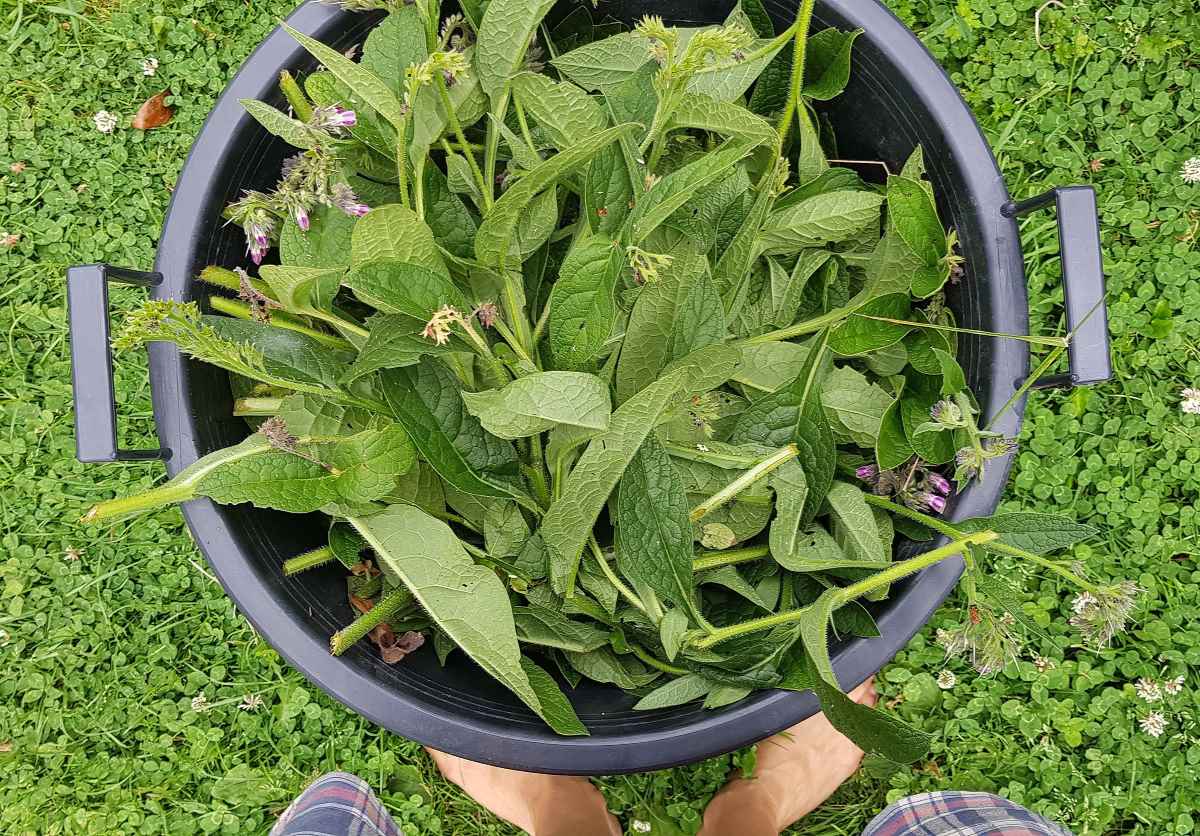Mineral Rich Comfrey: A Garden Essential!


Edible gardeners are mad keen about comfrey because she gathers and shares such mineral riches: silicon, calcium, potassium, phosphorus, iron, iodine... and more besides! This accumulation of minerals comes up from the deep, via a set of licorice like tap roots that open and aerate soil and create nutritious greens on top. A wonder plant indeed!
There is but one quality to be aware of when choosing where to plant comfrey. She stands her ground, and once established, wont budge, steadily increasing ever outwards. Not like wildfire, as rumour would have you believe. Grow Russian comfrey, symphytum x uplandicum, which spreads via clumping roots, not seed.
Design

Keep the ever clumping comfrey in check with boundaries like roads and driveways, animal runs or paddocks, mowing strips and regular harvesting. Beware of comfrey establishing amongst annual vegetables - it becomes tricky to navigate!
Here's a few design ideas:
- Include comfrey in the living mulch beneath deciduous fruit trees. Dot little groups of three root cuttings or plants, around the base, interplanted between other herbal companions. Comfrey really pulls her weight: creating a living mulch through the hot months, a mineral rich fertiliser after the foliage dies back in winter and a dynamic tap root year round - mining minerals, aerating heavy soils + holding light ones.
- Include comfrey in perennial (natives, flowers, herbs) areas, along the picking edge so you can easily harvest for composts and liquid feeds. In this way you can leave the comfrey beneath the fruit trees, alone.
- Grow as part of your animal/ chook fodder: Comfrey is a high value animal or chook food - being high in protein and low in fibre. Either grow along the edges of paddocks or runs, for grazing that doesn't annihilate the entire plant, or in rotational runs/ pasture to allow for rest and rejeuvenation.
Plant + Grow

If your soil is not that great - ie: dusty, soggy, poor, heavy - start your comfrey root cuttings in pots. Press root cuttings into potting mix and plant them out when sprouted and growing well. I
f your soil is all good, the root cuttings can go in direct.Plant cuttings in groups of three at 15/ 20cm spacings. In this way, they'll establish a alot faster - they support each other to get growing. Make a shallow trench about 4cm deep to accommodate each cutting. Fill it with compost and press the cutting in, flat on it's side. Cover generously with mulch, and bird protection too if needed.
Pay special attention to the new plants for their first summer by keeping any dominating weeds back. Water if they show signs of flagging, but otherwise let them go it alone - they come with water seeking roots!, and will fare better if you leave them to strike out. Splash gentle liquid feed on them every now and then.
- Steadily increase your comfrey by taking new root cuttings in spring, from 3 year old plus plants. Slide a sharp spade in close to the core of the plant and break off bits of root. It sounds rough, but worry not - comfrey thrives on being disturbed.
- Feed + mulch young comfrey plants in spring as leaves start to rise above ground. Spread whatever you have - compost, rotten manure, seaweed, scrapings from the chookyard etc, along the top, then top off with a generous portion of whatever brown, dry stuff you have around. Woodchip is fab.
Harvesting

You can harvest the foliage of mature plants (3 years plus), about 5 times from late spring through autumn (depending on their vigour). Use the plants in your perennial border - the comfrey beneath your fruit trees is busy being a living mulch.
Cut about 5cm above the crown of the plant. Higher is better as the white bits at the bottom of the leaves can (and will) resprout! I use a knife.
If you harvest often, be sure to dollop some compost, mulch, seaweed, manure alongside the newly cut plants - reciprocity if you will.
Use the leaves
- to make a nutritious liquid feed
- in the compost heap
- beneath seed potatoes
- to mulch kumara shoots or tomatoes. Lay dry brown mulch on top of the comfrey.
